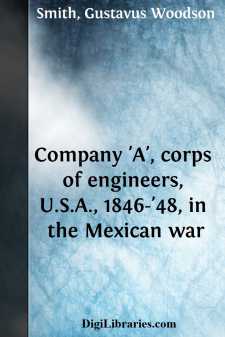Categories
- Antiques & Collectibles 13
- Architecture 36
- Art 48
- Bibles 22
- Biography & Autobiography 813
- Body, Mind & Spirit 142
- Business & Economics 28
- Children's Books 15
- Children's Fiction 12
- Computers 4
- Cooking 94
- Crafts & Hobbies 4
- Drama 346
- Education 46
- Family & Relationships 57
- Fiction 11829
- Games 19
- Gardening 17
- Health & Fitness 34
- History 1377
- House & Home 1
- Humor 147
- Juvenile Fiction 1873
- Juvenile Nonfiction 202
- Language Arts & Disciplines 88
- Law 16
- Literary Collections 686
- Literary Criticism 179
- Mathematics 13
- Medical 41
- Music 40
- Nature 179
- Non-Classifiable 1768
- Performing Arts 7
- Periodicals 1453
- Philosophy 64
- Photography 2
- Poetry 896
- Political Science 203
- Psychology 42
- Reference 154
- Religion 513
- Science 126
- Self-Help 84
- Social Science 81
- Sports & Recreation 34
- Study Aids 3
- Technology & Engineering 59
- Transportation 23
- Travel 463
- True Crime 29
Company 'A', corps of engineers, U.S.A., 1846-'48, in the Mexican war
Categories:
Description:
Excerpt
ENLISTMENT—INSTRUCTION—DETENTION ON THE RIO GRANDE—MARCH TO VICTORIA AND TAMPICO—LANDING AT VERA CRUZ—DEATH OF CAPTAIN SWIFT.
Previous to the war with Mexico there existed among the people of the United States a strong prejudice against maintaining even a small regular army in time of peace. Active opposition to a permanent, regular military establishment extended to the West Point Academy, in which cadets were trained and qualified to become commissioned officers of the army. That Academy was then a component part of the Military Engineer Corps. For years the chief of the Corps had, in vain, urged upon Congress, the necessity for having, at least one company of enlisted engineer soldiers as a part of the regular army.
In the meantime he had, however, succeeded in persuading the Government at Washington to send—by permission of the Government of France—a selected Captain of the U. S. Engineer Corps to the French School of engineer officers at Metz; for the purpose of having in the U. S. Army, an officer qualified to instruct and command a company of engineer soldiers in case Congress could be induced to authorize the enlistment of such a company.
Captain Alexander J. Swift was the officer selected to be sent to Metz. On his return to the United States, he was assigned to temporary duty at West Point awaiting the long delayed passage of an act authorizing the enlistment of a company of U. S. Engineer soldiers.
That act was passed soon after the commencement of hostilities with Mexico. It provided for the enlistment of an engineer company of 100 men, in the regular army. The company to be composed of 10 sergeants, 10 corporals, 39 artificers, 39 second class privates, and 2 musicians; all with higher pay than that of enlisted men in the line of the army.
Captain Swift was assigned to the command; and, at his request, I was ordered to report to him as next officer in rank to himself. At my suggestion, Brevet Second Lieutenant George B. McClellan, who had just been graduated from the Military Academy, was assigned as junior officer of the company.
At that time I had been an officer of engineers for four years; my rank was that of second lieutenant. All the first lieutenants, and some of the second lieutenants, of that corps, were then in sole charge of the construction of separate fortifications, or were engaged in other important duties. Captain Swift was not disposed to apply for the assignment of any of those officers to be subalterns under him in a company of soldiers.
I had taught McClellan during his last year in the Academy, and felt assured that he would be in full harmony with me in the duties we would be called upon to perform under Captain Swift. It is safe to say that no three officers of a company of soldiers ever worked together with less friction. The understanding between them was complete. There were no jars—no doubts or cross purposes—and no conflict of opinion or of action.
In the beginning I was charged with the instruction of the company as an infantry command, whilst the Captain took control of the recruiting, the collection of engineer implements—including an India Rubber Ponton Bridge—and he privately instructed McClellan and myself, at his own house, in the rudiments of practical military engineering which he had acquired at Metz....


